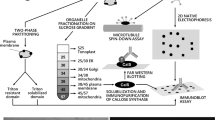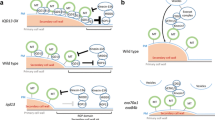Summary.
The roles of cellulose microfibrils and cortical microtubules in establishing and maintaining the pattern of secondary-cell-wall deposition in tracheary elements were investigated with direct dyes to inhibit cellulose microfibril assembly and amiprophosmethyl to inhibit microtubule polymerization. When direct dyes were added to xylogenic cultures of Zinnia elegans L. mesophyll cells just before the onset of differentiation, the secondary cell wall was initially secreted as bands composed of discrete masses of stained material, consistent with immobilized sites of cellulose synthesis. The masses coalesced, forming truncated, sinuous or smeared thickenings, as secondary cell wall deposition continued. The absence of ordered cellulose microfibrils was confirmed by polarization microscopy and a lack of fluorescence dichroism as determined by laser scanning microscopy. Indirect immunofluorescence showed that cortical microtubules initially subtended the masses of dye-altered secondary cell wall material but soon became disorganized and disappeared. Although most of the secondary cell wall was deposited in the absence of subtending cortical microtubules in dye-treated cells, secretion remained confined to discrete regions of the plasma membrane. Examination of non-dye-treated cultures following application of microtubule inhibitors during various stages of secondary-cell-wall deposition revealed that the pattern became fixed at an early stage such that deposition remained localized in the absence of cortical microtubules. These observations indicate that cortical microtubules are required to establish, but not to maintain, patterned secondary-cell-wall deposition. Furthermore, cellulose microfibrils play a role in maintaining microtubule arrays and the integrity of the secondary-cell-wall bands during deposition.
Similar content being viewed by others
Author information
Authors and Affiliations
Additional information
Correspondence and reprints: Department of Biological Sciences, University of Rhode Island, Kingston, RI 02881, U.S.A.
Present address: Biology Editors Co., Peacedale, Rhode Island, U.S.A.
Present address: Department of Biology and Marine Biology, Roger Williams University, Bristol, Rhode Island, U.S.A.
Present address: Department of Crop Science and Department of Botany, North Carolina State University, Raleigh, North Carolina, U.S.A.
Rights and permissions
About this article
Cite this article
Roberts, A., Frost, A., Roberts, E. et al. Roles of microtubules and cellulose microfibril assembly in the localization of secondary-cell-wall deposition in developing tracheary elements. Protoplasma 224, 217–229 (2004). https://doi.org/10.1007/s00709-004-0064-4
Received:
Accepted:
Published:
Issue Date:
DOI: https://doi.org/10.1007/s00709-004-0064-4




